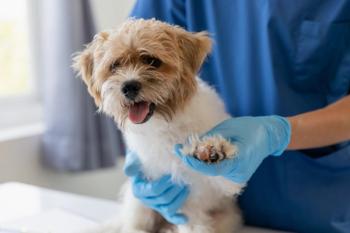
The bright side of vet life at the Veterinary Innovation Summit
Promising technologies and ideas abounded at the second annual event. Lets pause a moment to dream of the future-the near future, at that.
The second annual Veterinary Innovation Summit April 6-8 opened with Eleanor Green, DVM, DACVIM, DABVP, dean of Texas A&M's College of Veterinary Medicine and Biomedical Sciences, proclaiming her passion for innovation and technology. Among the reasons for Dr. Green's excitement? Innovation offers new career opportunities for veterinarians, it allows veterinary faculty and students to free their creativity and it helps the global community. “Vets can and do change the world every day,” she told attendees.
Dr. Green emphasized that the profession needs to embrace new possibilities, hearkening back to a comment from an entrepreneur who spoke at the summit last year: “We prefer to work with vets, but we will not wait on them.”
The summit, which hosted 462 attendees, was presented by the North American Veterinary Community's Veterinary Innovation Council and Texas A&M College of Veterinary Medicine and Biomedical Sciences. It was held on the vet school campus in College Station, Texas.
Here are a few highlights from the general sessions:
> New imaging technology from
> Disaster planning and rescue innovations utilized by the Texas A&M Veterinary Emergency Team during Hurricane Harvey helped the operation progress as smoothly as possible.
> The human-animal bond provides value for veterinary patients and clients and benefits a practice as well (see the research at
> Providing care to pets in low-income communities is essential-David Haworth, DVM, PhD, of PetSmart Charities, says 59 million pets in the United States are living in households making less than $20,000 a year. These owners want to be responsible pet owners, so he emphasized the three things they most need: physical access to veterinary care, options along a spectrum of costs, and general education about pet health.
Three applause lines from general sessions
To get the feel of a few of the other general sessions, take note of these comments from speakers that sparked instantaneous applause from the audience:
“We make better decisions when we include everyone.” This line from Charlotte Lacroix, DVM, JD, of Veterinary Business Advisors, occurred during a leadership panel. The audience rapidly responded to the clarion call of
“As we leverage technicians and nurses, we can compensate them better.” This came from Bob Lester, DVM, chief medical officer of WellHaven Pet Health, during a discussion on the future of practice models and ownership. This thread of the conversation focused on why there aren't enough technicians or nurses in veterinary practices. Why? Because too often they aren't empowered. The audience's audible response showed they wanted to help make sure veterinary technicians and nurses are able to use the skills they've learned-and
“We need to start encouraging young people again.” This was from Dr. Green on a discussion about training the next generation of veterinary students. These days many veterinarians are discouraging young people from pursuing veterinary medicine as a career. Want proof? In 2015,
Moments from the breakout sessions
Innovative ideas were also presented and dissected by attendees during breakout sessions. Topics included genomics and DNA testing, the
Know what's curious? Cats! This pretty girl, Bug, sure was on the edge of her seat during the summit. She was accompanied by her owner, Ken Lambrecht, DVM, the medical director of West Towne Veterinary Center in Madison, Wisconsin, who held his own breakout session on how emerging technologies for pet fitness and health can help with the obesity problem that only continues to grow. Some of the solutions he presented were ready access to body and muscle condition score charts for clients, calorie calculators from petnutritionalliance.org, portion control feeding devices, activity monitors and easy at-home scales (one for dogs is a pet bed, one for cats is a litter box).One of the more controversial sessions, judging by audience reactions, was on AI-artificial intelligence, not artificial insemination-and the ability to use in-home devices like Amazon Echo and Google Home to obtain veterinary advice. Yep, your clients might soon be able to ask Alexa, “I think my dog might have arthritis. What should I do?”
A conversation with an AI device might lead to recommendations for pet owners to consider a specific diet or drug, as it did in the demo: “For dogs with joint problems, consider X brand food.” No official diagnosis or prescription to be sure-the requirement for a veterinarian-client-pet relationship, or VCPR, keeps that in check for now.
Ask.Vet also includes a Vet-to-Vet feature that walks veterinarians through the best diagnostic procedures and other advice for a specific problem and lets them connect with a board-certified expert. Cal Lai, Ask.Vet CEO, and Cherise Roth, MS, DVM, director of veterinary operations and programs, stated that the future of search is voice. We're not there yet, but it's coming, they say.
About inspiring those future vets …
Overall, Veterinary Innovation Summit attendees were optimistic about the future. Several speakers espoused that this is the best time to be in veterinary medicine. Attendees who engaged with the enthusiasm of Dr. Green and others seemed to want to be excited about the profession again and invite the young into the wonders of veterinary medicine.
All of the sessions were held in the Veni and Vidi buildings of the recently built Texas A&M veterinary school complex. This Caesarean reference (we're talking ancient Rome here, not obstetrics) brings a nice analogy to the experience-the attendees came; the attendees saw; the attendees are ready to conquer and love veterinary medicine again.
Newsletter
From exam room tips to practice management insights, get trusted veterinary news delivered straight to your inbox—subscribe to dvm360.




